Porcelain Insulator News
by Elton Gish
Reprinted from "Crown Jewels of the Wire", May 1993, page 22
This month we will devote this space to multipart porcelain insulators. This
continues to be an ever growing part of our hobby, even though some have thought
in the past that these "boat anchors" would never "fly" with
collectors. Those of us that are devoted multi collectors manage to find room
for these long overlooked jewels. One thing that makes collecting multis fun is
that they can be found almost anywhere. The following story is a good example of
where these jewels may be found, and also presents an interesting idea of how to
use them to best advantage.
Peter Hoffman sent in the following, which I am sure
you will find interesting. Peter said: "I've only just received my second
issue of Crown Jewels (Dec. 92 and Jan. 93), and have enjoyed your PIN article
quite a bit. I thought I
would share an anecdote about one of my multi finds. My wife and I went to an
antique store in Flagstaff, AZ to see if they had any insulators. After picking
out several glass and porcelain insulators, my wife pointed at something and
said, "Isn't that an insulator?" Well, it was. It was the 12"
diameter M-2927 sitting upside down, and it had the marking,
"LOCKE/1055". The label said "Vegetable Tray", and it was
marked down one-half price! The person working in the store told us that the
dealer thought it was an ugly vegetable tray, and he wanted to get rid of it.
Obviously, he had no idea what it was used for. This story has found much
delight with our friends."
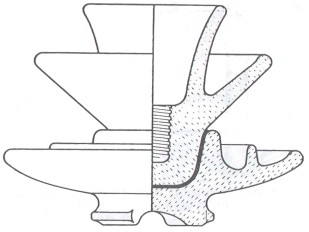
Unique vegetable tray (M-2927)
I thought that was a wonderfully funny story, and when I read Peter's letter
to my wife, Kathy, she got a big laugh out of it, too. I have heard of using
multis for candle holders, and chip and dip trays, but never thought to use one
for a vegetable tray. Great idea! (?) Thanks, Peter, for that humorous story.
Jeff Kaminski (NIA 3582) has been aggressively tracking down multi parts that he
does not have in his collection. He was very fortunate to acquire one of the
mottled gray M-4395 Ohio Brass cross-tops at last year's London, Ohio show.
These are very large and heavy insulators, and they are quite rare, too. When I
published the book, Multipart Porcelain Insulators in 1988, I thought that this was the same insulator that
was used on the Niagara, Lockport and Ontario line, in early 1909, to replace
the M-3890's. I even used a photograph of this insulator in my book, which was
from the March 31, 1910 AlEE Journal, to represent M-4395. However, when Ken
Willick found a damaged specimen along the Niagara, Lockport and Ontario line, I
realized that I had made a mistake, and assigned this "new" find
M-4338. It exactly matches the one in the 1910 AlEE article. Ken's M-4338
specimen was marked "VICTOR", and it was much smaller than M-4395. He
repaired it to a very nice display specimen, and
Jeff managed to talk Ken out of it. In Jeff s two photographs, you can easily
see how different these two styles are. M-4338 weighs 33 lbs. and M-4395 weighs
52 lbs. Ken recently found, and pieced together, most of another M-4338 specimen.
These two are the only known specimens of M-4338.
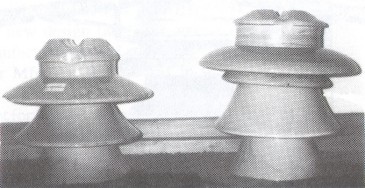
M-4338 on the left (14 -12 -10 - 5 x 13.5) and
M-4395 on the right (14.5 -
9.5 -11.5 - 9.5 x 15.5)
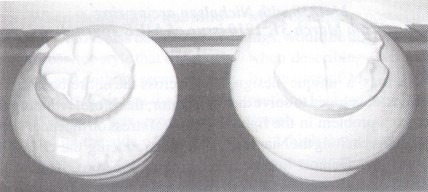
Crown detail of M-4338 (left) and M-4395 (right)

M-4338 with Nicholson arcing ring
(from March 31,1910 issue of AlEE Journal)
M-4338 was a unique design, which was developed to solve the puncturing
problem in the lightning prone area along the Niagara, Lockport and Ontario line
(see PIN in CJ dated November, 1991 for more details). M-4338 was specifically
designed to be six inches shorter than M-3890. They found that the long, thin
insulator shells, as in M-3890, could not resist the mechanical shock of
lightning. Moreover, they discovered that short shells would allow a more even
distribution of voltage across the entire body of the insulator; therefore, reducing the
electrical stress on the inner shell, and thus reducing the chance of electrical
puncture. The shells were made thicker, too, to resist breaking, and a fourth,
recessed inner shell was added for additional protection against puncture;
however, the inner shell probably was not needed. In short, the new four-part
insulator was designed to flash over before reaching the stress level needed to
puncture the porcelain shells. This was the first realization of the benefit to design insulators with a diameter to
height ratio of less than 1:1. The new design (M-4338) was manufactured by the
Locke Insulator Mfg. Co., and it was installed in early 1909 as a
replacement for M-3890. The failures of tens of thousands of M-3890's on this
line is why this style is so rare. A whole M-3890 has yet to be discovered, but
Steve Jones has high hopes of finding all of the necessary parts. He only needs
the second shell to complete a whole specimen. Good luck, Steve!

M-4338 as shown in the 1910 Locke catalog
When the M-4338
was introduced, Ohio Brass decided to offer a cross-top style that was much
larger, and without recessing the fourth skirt. This was the gray M-4395, and it
was prominently marked on the side of the crown with a very large version of
their embossed O-B marking. Note that I said "embossed". It seems that
most collectors persist in using the glass terminology, "embossed",
when most porcelain insulators are actually incuse marked (marking is recessed
into the surface). Just like the stopped clock is right twice a day, the
persistent use of "embossed", when describing porcelain markings, would be unknowingly right when
describing O-B markings. In the case of M-4395, the O-B marking is about the
size of your thumb.
I think that it was Ken Stefan who sent me the following
drawing several years ago from an AlEE Journal. This piggy-back arrangement,
with M-4395 on top, was used at railroad crossings. You may not be able to make
out the numbers, but the drawing shows M-4395 with a top skirt diameter of
15" and the bottom insulator has a 17" top skirt. Note that the bottom
insulator has a metal cap cemented on the crown, which has an attachment for the pin to
support M-4395. I did not get all of the text of the article, but what was
included said that this tandem arrangement was used on one 66 kV line. It was
apparently designed to withstand voltage surges from lightning, to prevent the
insulators from "spilling". There wasn't a problem with puncturing
with these large, thick insulators. The electrical surge was the determining
factor for insulation, not the normal line voltage. M-4395 evidently found limited use, since few specimens exist.
A
similar piggy-back arrangement has recently been reported by Ken Willick (NIA
#3709) in New York. Note in the two photographs that both the top and bottom
insulators are M-4395's. The steel pin in the top insulator is attached to a
mounting bracket, which is apparently clamped to the crown of the bottom
insulator.
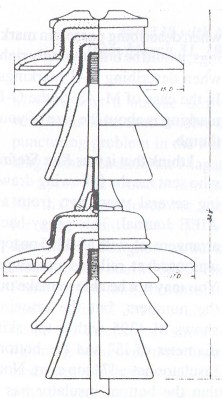 |

Seven more M-4395's. Note the one mounted horizontally. |
Bill Rohde (NIA #1219) reported a new find, but it is frustrating that he
cannot find a way to add it to his collection. He has sent me several batches of
photographs of this insulator, which, by the way, is still in service. We
finally identified this unique style, and it has been assigned M4321C. I found a
drawing of this insulator in the 1910 Locke catalog. If l remember correctly,
Bill said that this is the only insulator like it along the many miles of this
California line. That is all the information that Bill was willing to share -- that it was in California. Understandably, he keeps a close eye on
this beauty.

M-4321C from 1910 Locke catalog

Locke M-4321C
There have been several reports during the past year regarding
an unusual porcelain item, which looks very much like a baby rattle (for a
exceptionally strong baby), so it is time once again to publish the answer to
this "what-is-it's.
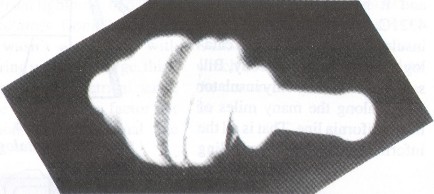
Jim Overstreet (NIA #2595) sent in the nice close-up
photograph. The following marking is embossed around the bottom porcelain ring:
KENT PRODUCTS CO. CHICAGO, ILL. U. S. PAT. NO.2,376,410
Many people think that it may be some sort of specialty
insulator, but it was never intended to be used as an insulator. Actually, it is
the internal filter device for a percolation coffee filter. As evidenced by so
many of these turning up at flea markets over the past 20 years, I would guess
that the idea was not very successful, even though many were apparently sold
across the country. Following is the drawing from the patent. If anyone desires
a full copy of the 4-page patent, I will be glad to furnish it upon receipt of
$1.00 and a large SASE.
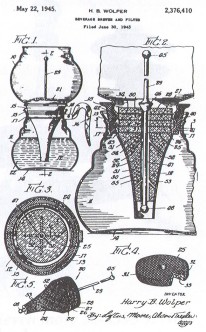
|
